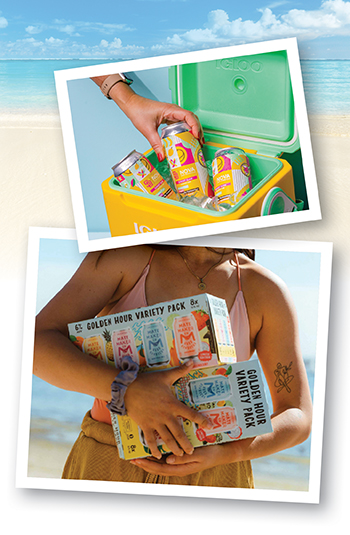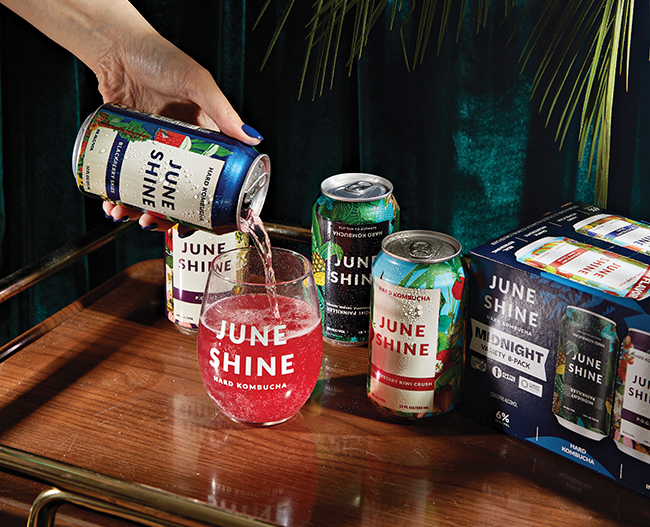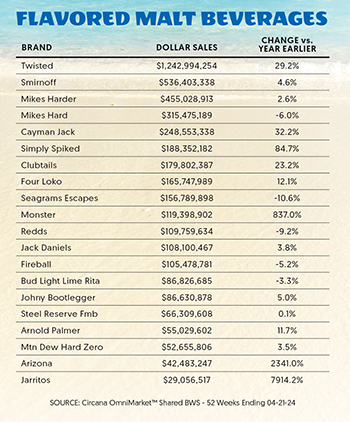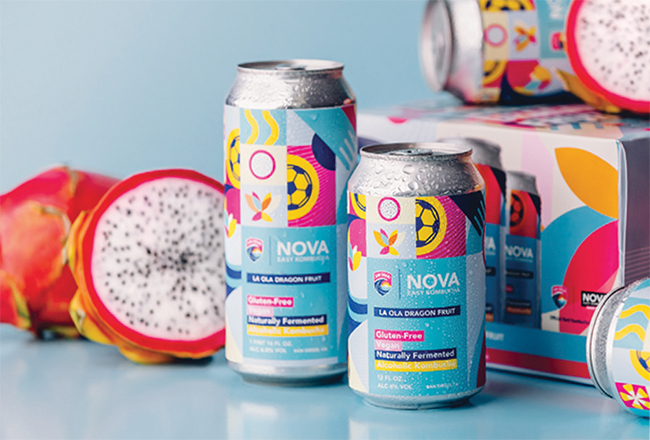Hard Kombucha’s Path to Success: Slow, But Possible
Five years ago, hard kombucha was supposed to be the next big “fourth category” product, building off the initial momentum of hard seltzer, but promising bolder flavors and potential gut health benefits.
The fermented beverage, made mainly with tea, sugar, and a symbiotic culture of bacteria and yeast (SCOBY), accounted for $3.8 million in dollar sales in Circana-tracked off-premise channels in 2018, more than double the previous year. Meanwhile, the overall kombucha segment was a $1.2 billion industry in the U.S., and was on pace to be a $5.45 billion industry by 2025, according to Grand View Research, Inc.
By 2020, total kombucha had grown to just $1.8 billion, and hard kombucha made up about $12 million of that. And in the past two years, hard kombucha has faced declining numbers, even past the initial effects of the COVID-19 pandemic.
The apparent stall of the segment is not a mark of failure, but rather a harsh mix of bad timing, off-point consumer marketing strategy, and unrealistic early growth expectations, according to many still playing in the segment. Slow and steady might still win out, they believe.
“I saw some brands trying to go national and then failing and then coming back to their original markets,” NOVA Easy Kombucha founder Tiago Carneiro said. “They tried to buy market expansion, but the velocities weren’t there.”
Carneiro, who is also the creator of NOVO Brazil Brewing, launched NOVA during the initial hard kombucha boom in 2018. The brand is headquartered in San Diego, California, part of the largest hard kombucha market in terms of volume and consumer demand.
Despite the push to go national in 2018/2019, NOVA’s strategy is to focus locally, creating a brand that connects to consumers directly in San Diego, rather than marketing to a broader audience. Carneiro is also highly critical of the early strategies embraced by producers, retailers, and investors when it came to expanding hard kombucha.
“The market was not growing – it was growing because you were forcing the growth,” Carneiro said of the initial exponential growth of the segment. “Once you don’t have money anymore, you cannot do big promotions, you don’t do big price discounts anymore and then people stopped [buying].
“You need to build a base learning first of consumers, before you do bigger jumps to go national,” he continued.
Carneiro blamed much of hard kombucha’s folly on an influx of investment in initial adopters to the category, which spurred quick expansion and growth before consumers fully understood what hard kombucha was.
“Imagine in the ’80s, you got all these venture capital funds and all this money and people flooded money to accelerate craft [beer] … doesn’t matter, [the growth] would not happen in the ’80s how it is right now,” he said. “You need time for a category to be measured and people to understand what it is and accept the product – you cannot buy this time.”
Kombucha’s Reputation Problem
Non-alcoholic kombucha brands highlight the health-centric characteristics of the beverage, including high levels of probiotics. Initial alcoholized versions of the drink leaned into the “better-for-you” image. But marketing alcohol as “healthy” is hard (and a great way to open yourself up to legal action).
“We need to be responsible as brand owners to be transparent with people and tell them that drinking isn’t healthy – you’re not going to be functionally better for drinking this,” said Mate Maker co-founder Justin Medcraft.
“The category back then was really struggling with this messaging, because it was so dependent on how kombucha had established itself through the functionality,” he continued. “That’s been pushed so much as a core message where people don’t care.”
Medcraft sees Mate Maker as both a “fast mover and a fast follower” in the hard kombucha space. The company was a fast mover in Australia, where it was founded in 2022 – one of the first hard kombucha brands in the country, as Australia is typically about “five years behind on trends,” Medcraft said.
In 2023, due to both personal circumstances and the extra education needed to market hard kombucha Down Under, Mate Maker became a “fast follower” and launched the company in the U.S., headquartered in San Diego. Like NOVA, Mate Maker is also focused on its home market of Southern California for now, in large part due to hard kombucha’s barriers to entry on a national scale.
“The tension that we’re looking at at the moment now is hard kombucha still has a bit of a stereotype attached to it,” Medcraft said. “There’s two very different motivations for kombucha and hard kombucha – the reason people buy them [and] the occasion is different.”
The key for hard kombucha to return to growth is to attach itself to those characteristics that factor into consumers’ buying decisions, including flavor and quality, Medcraft said.
“We’re looking through this lens of mainstream drinkers [and] what are they looking for,” Medcraft said. “People are wanting refreshment, they’re wanting flavor, they’re wanting to knock off work and have a fruity refreshing beverage with their mates.
“Whether or not the word kombucha has a lot of legacy attached to it, we’re really focused on not talking the kombucha language,” he continued. We’re talking macros, flavor, refreshment, sustainability … all of those things that time and time again worked for the alcohol category.”
Medcraft has first-hand knowledge of what has previously worked for bev-alc. His resume includes more than six years at Diageo, dedicated to managing Smirnoff, followed by time at Pabst and Firestone Walker. Now in hard kombucha, he is still looking at what’s working outside of the segment to guide Mate Maker’s growth.
“There’s opportunity for us to look at why are the other categories winning,” Medcraft said. “Why is [Gallo’s] High Noon doing so well? Why did hazy IPA reinvigorate the craft category? Because it focused on flavor, it focused on real fruit juice and bringing ingredients that opened up that product to a much wider drinking set.”
“Better-for-you” is also a popular trend in bev-alc, but it’s different from what hard kombucha was trying to do before, according to Giuseppe Infusino, chief investment officer at InvestBev, which made a seven-figure investment in hard kombucha maker JuneShine earlier this year.
“I have a thesis or belief – and I think that it’s been proven out – that better-for-you is a subjective thing, and there’s actually a trend behind that trend, of transparency, that’s much more important to today’s consumer,” Infusino said. “Hard kombucha as a general truth has some of these underlying components that might appeal to this transparent-seeking consumer and that will stay on trend and continue to grow.”
How much a hard kombucha brand should still lean into the better-for-you trend is dependent on the brand, but as a broad rule, “leaning too hard” is not the right move, according to Infusino.
“When you’re in the social imbibing environment [as a consumer], you want to be a little more thoughtful, more conscious, but you don’t want it in your face around health consequences, [and the] pros and cons of alcohol,” he said. “As a tie-breaking component of, ‘Should I drink this, versus drinking that?” I think it’s helpful. But as a reason to choose this one thing, I don’t think you should be leading with that.”
Hard kombucha and hard tea maker Jiant, also based out of California, has taken that flavor-first approach when marketing its offerings, including a line of cocktail-inspired hard kombuchas, which take advantage of consumer demand for ready-to-drink cocktails (RTDs) and higher ABV.
Jiant’s Taco Tuesday Pineapple Spicy Margarita (8% ABV) has grown +50% in the last 52 weeks, and it’s due to the brands emphasis on flavor, as the “kombucha aspect kind of blurs in the background,” according to Jiant co-founder Larry Haertel Jr.
“The majority of people who pick that up don’t even know that it’s a hard kombucha and they enjoy it, and then discover later,” Haertel Jr. said.
“We’re all so close to it,” he said of the bev-alc industry. “We talk about categories and talk about SKUs, we talk about packages, size format, all those things. But the consumer, they’re just shopping by flavor and what looks good to them. So we always have to remind ourselves to put ourselves in the shoes of the consumer.”
Jiant launched as a hard kombucha company in 2018, but in recent years has capitalized on hard tea demand, and finished 2023 by closing a $6 million Series A capital raise. Hard tea also became the majority of Jiant’s business in the second half of 2023.
“What we’ve found with hard tea is it just works in so many more channels – whether it’s conventional grocery, or c-store or venues – and it works in more geographies than hard kombucha does,” Haertel Jr. said. “It’s just a bigger category. There’s already some built-in category awareness thanks to brands like Twisted Tea and thanks to iced tea in general being a household type of product.”
However, Jiant has no plans to step away from hard kombucha, and has been able to find growth for its offerings outside of just California. Its hard kombucha is distributed in 25 states, with its core consumers in California, Colorado and New York. The company has also found growth in other mountain regions, including Utah, where the company sees some of its highest rate of sale.
A huge opportunity hard kombucha gives for Jiant and its retail partners is capitalizing on RTD trends in markets and channels where spirits-based offerings can’t be sold.
“When we look at a grocery store in New York, we’re able to bring that consumer and that retailer a cocktail-inspired flavor that’s not spirit-based, then we’re adding value to their shelves and to that consumer,” Haertel Jr. said. “And also hopefully having them discover something new that they really enjoyed and hopefully they’ll discover all of our other products as well.”
“Our approach is to lean in on the quality and the cleanness of the ingredients, particularly compared to hard seltzer, which is made in a lab,” Jiant co-founder Aaron Telch added. “There’s a broader base of consumers where that’s important, so that’s the messaging we lean on.”
Brand is Key (Especially if You Want Funding)
So what could lead to a revival of the hard kombucha segment? Multiple suppliers in the market think that strong brands will be the key to gaining the attention of consumers, and to potential investors.
“When it comes to investment and the venture community and how they’re looking at these sorts of opportunities, it’s really not about the product, it’s about the brand stuff – the people behind the brand – and coming up with these long-term plans to build an audience that is captivated by your products and will continue to support you,” said Haertel, who also noted that many Jiant consumers are now discovering the brand through hard tea, and then staying loyal to both its hard tea and hard kombucha products through the brand’s reputation.
“Hard kombucha is definitely a bad word in the venture community,” Haertel continued. “One that we certainly don’t put in the subject line of any emails that we’re sending out.”
Investors haven’t completely stalled their interest in hard kombucha, but industry members aren’t seeing as many eight-figure investment rounds as they were just three years ago.
“The fervor that was there a couple years ago is not as pervasive as it was, which is somewhat healthy for the market, because brands that unfortunately shouldn’t necessarily exist, won’t, and won’t get the capital,” Infusino said. “And then they also won’t compete with the brands that should exist, so the cream will rise to the top a little bit and there’ll be a little bit of a culling of the herd.
“That’ll be, from an investor perspective, helpful, from a distributor perspective, helpful, and from a retailer perspective, helpful, as everyone’s not being inundated with options,” he continued.
The change in investor interest isn’t as much a strike against hard kombucha, but rather greater hesitancy across all bev-alc investment, according to Infusino, as trends move quicker and brands appear less stable. It has also forced companies to be more on top of the financial structure of their business and to become strong on a smaller scale, so they can be more self-sustaining and not rely on outside capital.
“I’m seeing brands tightening the belt a little bit in terms of spend and growth, and thinking about their business as more of an ongoing concern, as opposed to ‘I’m just burning capital to go raise again, to burn capital again, to then ultimately be acquired,” Infusino said.
InvestBev’s interest in JuneShine was not solely based on enthusiasm for the California brand’s hard kombucha offerings, or even its spirits-based canned cocktails, which it launched in 2023, but rather the reputation of the JuneShine brand and the overall strength of its entire portfolio.
That portfolio grew even larger after InvestBev’s investment with the launch of Easy Rider, a light lager brand, and JuneShine’s acquisition of hard kombucha and flavored malt beverage maker Flying Embers. The all-stock deal brings 63% of all hard kombucha sold in the U.S. under one roof, with the combined portfolio exceeding 116,000 barrels, or 1.6 million cases, annually.
“If I were starting JuneShine today, I think it would be difficult to raise the money that we did,” JuneShine co-founder and chief marketing officer Forrest Dein said.
Unlike the majority of the players in the hard kombucha space, JuneShine has been able to find growth on a more national scale, making the company the 14th largest beyond beer and spirits-based RTD brand family in the country, the company said at the time of the deal. Flying Embers has only strengthened JuneShine’s national reach, according to Dein, combining JuneShine’s strength in New York, Colorado and the Northwest with Flying Embers’ dominating presence in North Carolina, Austin, Texas, Pennsylvania and other areas in the Midwest.
“We’ve done the hard work of investing in building a national brand, and so has Flying Embers to some extent, so that’s really what sets us two apart, what we’ve done to win in a space where people don’t know what the category is,” Dein said.
“It would be tricky for a new hard kombucha brand to scale nationally today, just because of how capital intensive it is and how tricky it is to raise capital right now, which is a big reason why we wanted to get profitable,” he added. “We’re lucky now to be at a scale where we can be profitable and stand on our own two feet and not rely just on investors.”
Being Small and Regional Isn’t A Bad Thing
Participants in the hard kombucha segment all agree that hard kombucha has a future, and has plenty of potential to become a larger segment. But that takes time.
So what happens to the segment in the meantime?
There are two leading strategies. The first is to take the route of those like NOVA and Mate Maker and stay focused on growing the brand on a small, regional scale. Even in California, the leading and most crowded hard kombucha market, there are still white spaces within the segment.
“There’s still people that haven’t tried it,” Medcraft said. “California is a huge place. It’s the fifth largest economy on the planet. I look at California like a country – it’s double the size in population of Australia.”
NOVA has prioritized connecting with the San Diego community through sports partnerships, integrating hard kombucha into more occasions than consumers may have seen in the past, including partnering with the San Diego Padres Major League Baseball team and San Diego State University (SDSU) Men’s Basketball.
The latter, which includes supporting a Name, Image and Likeness (NIL) fund for SDSU student athletes, has also helped NOVA connect with the youngest legal-drinking-age (LDA) consumers, and learn about their flavor preferences, with LDA players helping forumate a collaboration flavor that was NOVA’s No. 1 brand at retail during the basketball season.
“It was something that started relatively with the consumer and then we created the flavor, not the opposite, [where] we in the industry tried to put out the flavor that we’re saying will communicate with them,” Carneiro said.
“I was always very focused on the quality, the liquids and improving our flavors and improving our relationship with our community, and that’s why I think we keep growing,” he added.
The regional connection isn’t exclusive to California either. Brands such as Walker Brothers have found success outside of that largest market. The Nashville, Tennessee-based company, founded in 2019, has focused on just a few markets in the south. In the last 52 weeks, ending April 20, the brand recorded double-digit dollar sales (+47.1%) and volume (+56.2%) growth in NIQ-tracked off-premise channels (total U.S. xAOC + liquor plus + convenience).
“It’s difficult because it’s hard [and] it’s expensive to make in a smaller scale,” Infusino said. “So if you somehow can optimize the production side of it and have unit economics that makes sense, and then stay small enough and regional enough that you don’t need a huge sales team, you don’t need a huge broad marketing [team], you may be able to do that.”
The second direction is for hard kombucha makers to branch out into other segments and build brand reputation while they wait for consumers to be ready for hard kombucha.
Chicago-based Luna Bay Booch Co., a female-founded hard kombucha brand that recorded record expansion in 2022, has struggled in recent scan data (dollar sales -40.7% in the last 52-weeks). Pivoting, the company launched its first innovation outside of hard kombucha last year: Clubhouse Sparkling Hard Tea (5% ABV), inspired by classic cocktail flavors. And in November, the company launched a line of 0% ABV tea-based mocktails, capitalizing on consumers interest in RTDs and non-alc.
“I’m watching how people’s drinking habits are becoming more diverse – and I am proud of how Luna Bay is innovating for more occasions,” Luna Bay CEO Bridget Connelly said in a press release at the time of the launch. “If someone chooses to not drink, we want them to feel included and be a part of the celebration with a booze-free option in hand.”
Medcraft envisions many brands turning into brand platforms, where consumers know about a company based on its quality and ingredients, but have a variety of products to choose from.
“Consumer trends and tastes are changing so rapidly – just because one product or one category is hot now, doesn’t mean that it’s going to be hot in the next three years,” Medcraft said. “We’ve got innovation plans for the next three years really thinking about how do we keep delivering on an occasion that’s growing and the motivations, which are refreshment and flavor, and then take that as our platform and launch lots of different products.
“The speed at which you do that is the trick,” he added. “It can be really tempting to try and launch lots of different products really, really quickly and hope that they stick. But that’s a really dangerous place to be in.”
“Would we have made the investment in Juneshine if they were just hard kombucha?I think the answer would be ‘probably not,’” Infusino said. “Hard kombucha has proven to be a decent sized category, but it’s never going to overtake beer. It grew quickly and now it’s going to grow incrementally.”
JuneShine itself hopes to follow the trajectory of Boston Beer Company, with the potential to be “the Boston Beer of the Southwest.”
“We don’t just want to chase trends, we want to build value over a long period of time,” Dein said.
“We really want to be the Angry Orchard of this category, where in 25 years people are like ‘Holy shit, hard kombucha is a huge category and JuneShine has 70% of it, how did that happen?” he added. “And it’s because we just made consistently delicious quality products for 20 years. That’s how you build valuable brands and big categories. It’s rare that you see the White Claw, $2 billion growth in three years.”


Receive your free magazine!
Join thousands of other food and beverage professionals who utilize BevNET Magazine to stay up-to-date on current trends and news within the food and beverage world.
Receive your free copy of the magazine 6x per year in digital or print and utilize insights on consumer behavior, brand growth, category volume, and trend forecasting.
Subscribe


